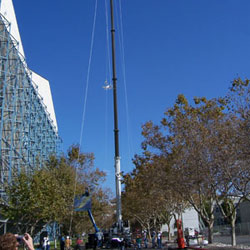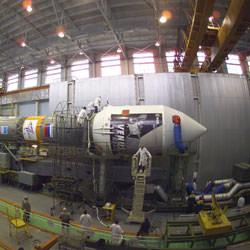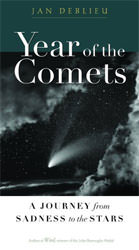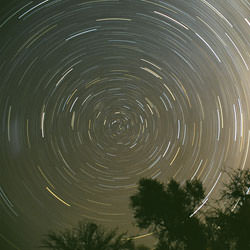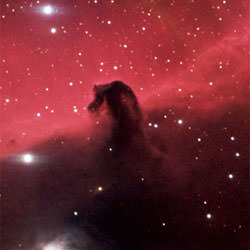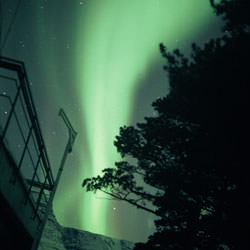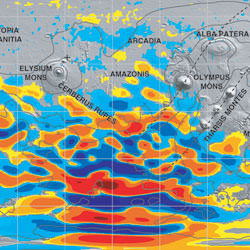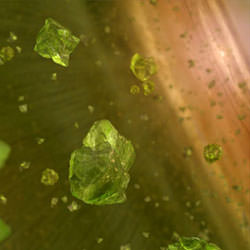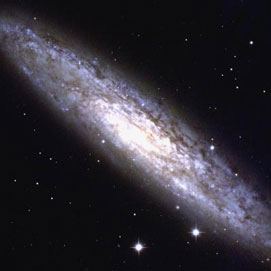
NGC 204. Image credit: Todd Boronson NOAO/AURA/NSF. Click to enlarge.
Monday, October 24 – With the Moon well out of the way, the return of dark skies favours having a look at an incredible southern galaxy in Sculptor – NGC 253.
Located about one third the way between Alpha Sculptor and Beta Ceti, NGC 253 was discovered by Caroline Herschel in 1783 during a comet search. As the brightest member of the “Sculptor Group”, this large and beautiful galaxy is also one of the closest outside our “Local Group” and will be readily apparent in binoculars for southern observers. Mid-to-large telescopes will be delighted with its many bright knots and dark obscured areas. For more northern observers, wait until the constellation is at its highest to catch a glimpse of this awesome 7th magnitude southern study.
Today in 1851, another astronomer was busy at the eyepiece as William Lassell discovered Uranus’ moons Ariel and Umbriel. Although this is far beyond backyard equipment, we can have a look at the blue/green planet. Now around magnitude 5.5, Uranus can be spotted in even small binoculars, but it will be harder to find it than it will be to see it! Start in Aquarius northeast of Sigma while waiting on Sculptor to rise…
Tuesday, October 25 – And who was watching the planets in 1671? None other than Giovanni Cassini – because he’d just discovered Saturn’s moon Iapetus. Before dawn this morning, look for Saturn about half a fist-width below below the Moon. You just might catch Iapetus very close to the rings.
If you feel like another planet challenge, then head towards open western horizons because Mercury is also making a dim appearance. About a half hour after sunset, go out and start with Venus. Using binoculars, identify Antares less than a handspan lower to the west. Scan directly below Antares for this elusive planet so near the horizon.
Today is the birthday of Henry Norris Russell. Born in 1877, Russell was the American leader in establishing the modern field of astrophysics. As he namesake for the American Astronomical Society’s highest award (for a lifetime contribution to the field), Mr. Russell is the “R” in HR diagrams, along with Mr. Hertzsprung. This work was first used in a 1914 paper, published by Russell.
What is an H-R diagram? Like people – stars grow up and age. But unlike humans, they are all very different in terms of size and weight at their beginnings. Massive stars live short lives and put out a lot of light. Low mass stars are very dim but continue to glow for billions of years. Our Sun is low mass star, but in the end it will do what most stars do – swell up to enormous size. It will turn red, expend its fuel, then expire. What’s left will be a very small white dwarf – glowing mostly by stored up heat. H-R diagrams pull all these factors together – young stars, old stars, bright stars, and dim stars.
Let’s look at Antares. It’s a relatively old, massive star – very bright and destined to end brilliantly. Or Markab – an aging blue dwarf soon to become a red giant. Now look at Deneb. It’s a supermassive blue giant shining as brightly as some globular clusters – yet fated to create another supernova remnant in Cygnus within 100 thousand years… Take a look at Enif – a spectral class K orange supergiant radiating with as much light as 7000 suns – yet it burns fast and is cooler than Sol. How about Polaris? Hotter than Sol, it’s another star about to enter a glorious retirement. Thankfully, our Sun is right in the middle of the wonderful H-R diagram!
Wednesday, October 26 – Tomorrow Neptune ends its retrograde, or westward, journey across the sky and will slowly begin to travel east. At 8th magnitude, it’s within binocular range and can be found west of Theta Capricornii.
Tonight let’s go hunting for the “Blue Snowball”. It’s proper name is the NGC 7622 and you find it around five degrees due east of Omicron Andromedae. At magnitude 9, this one challenges binocular users and presents the same problems as locating the M57 – low power will show you something – but not what it is. In a telescope, the “Blue Snowball” is almost as large as the “Ring” nebula.
Thursday, October 27 – This morning, look for the crescent Moon as it visits in Leo and makes a grand appearance with Regulus.
For those of you with larger telescopes who are looking for a real challenge, try your hand at roughly 10th magnitude comet C/2005 E2 McNaught. Now cruising just southwest of star 62 Sagittarius, look for what appears to be a faded and unresolved globular cluster.
Something a bit brighter? Then try your hand at asteroid 89 Julia. At magnitude 9.4, you’ll find it around 600 light seconds away just north of Beta Andromedae. You’ll find excellent locator charts at Heaven’s Above.
Friday, October 28 – Today in 1971, Great Britain launched its first satellite. For our friends in Russian, you will have a chance to see the Moon occult Sigma Leonis on this universal date. Please check with IOTA for more details.
Within the next 24 hours, Mars and Earth come will come the closest for this year. At some 43 million miles away, it doesn’t appear much like the size of the Full Moon, does it? Every two years we pass each other in our orbit around the Sun, and although we aren’t as close as we were in 2003, it will be another 13 years before we’re this near again.
Don’t leave your telescope inside. Don’t worry if you only use binoculars or just your eyes. Mars is simply superb right now and you cannot miss it’s ruddy color. For many of you, one of the largest and most easily spotted features, Syrtis Major, will now be in plain view. Appearing much light a deep, dark triangle, look closely for the lighter oval of Hellas Basin towards the pole. Still, others may see Mare Cimmerium, looking much like an antler – or Mare Erythraerum whose “fingers” reach toward Chryse. No matter where you are, wait until Mars is well risen for the very best views and enjoy!
Saturday, October 29 – On this night in 1749, French astronomer Le Gentil was at the eyepiece of an 18′ focal length telescope. His object of choice was the Andromeda Galaxy, which he believed to be a nebula. Little did he know at the time, his descriptive notes also included the M32, a satellite galaxy of the M31. It was the first small galaxy discovered and it would be another 175 years before they were recognized by Edwin Hubble as such.
Perhaps where you live, tonight will also be celebrated as “trick or treat”. If so, why not give your tricksters a real treat and view the Andromeda Galaxy? Be sure to take the time to look for both the M32 and M110 – both are fine galaxies in their own right. If skies are too light, put bright Alberio in the eyepiece!
Sunday, October 30 – Tonight let’s head toward an early evening study as we take a look at the departing M57. Located almost centrally between Beta and Gamma Lyrae, the “Ring” will appear as an out-of-focus “star” in the populated field for binoculars and resolve into its namesake for even the smallest of telescopes. This round shell of gas surrounding an expiring star will make a excellent conversation piece for any “Halloween” party.
Before you leave, take another look at Mars. Still a week away from opposition, right now is the best time to let it rise high to catch a stable look at the surface features.
I would also like to thank Jeff Barbour for his input this week. We’re all just a little bit closer… Under the stars! Until next week? May all your journeys be at light speed… ~Tammy Plotner
